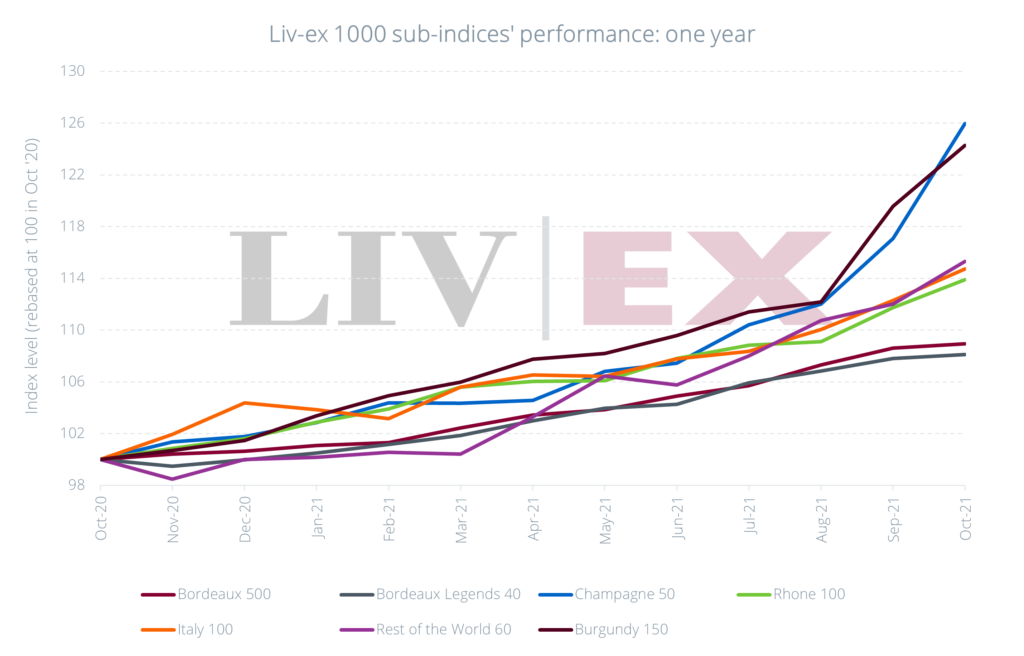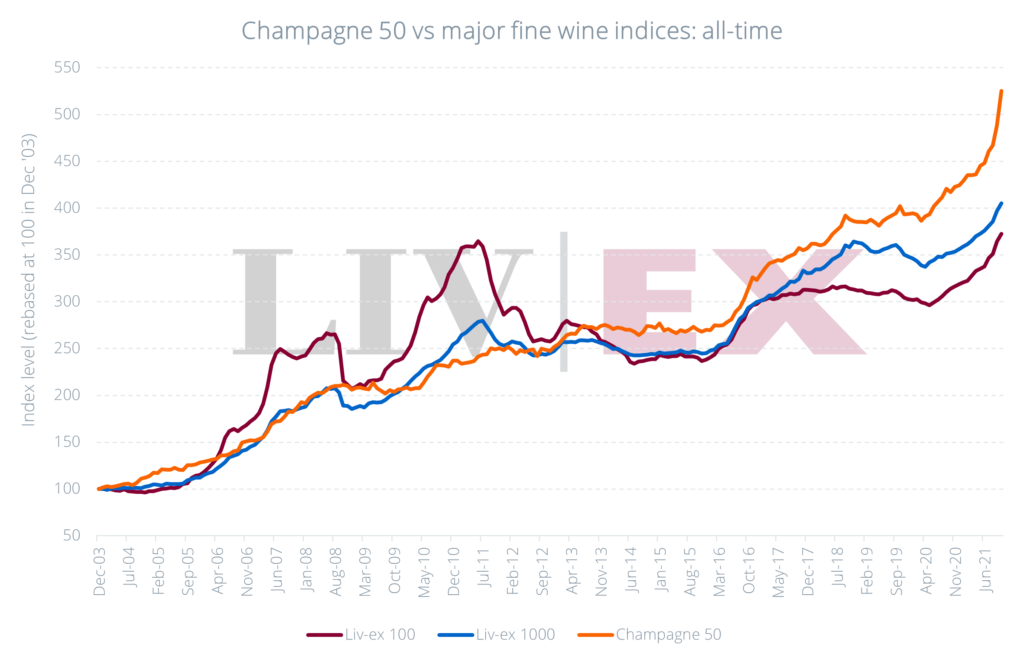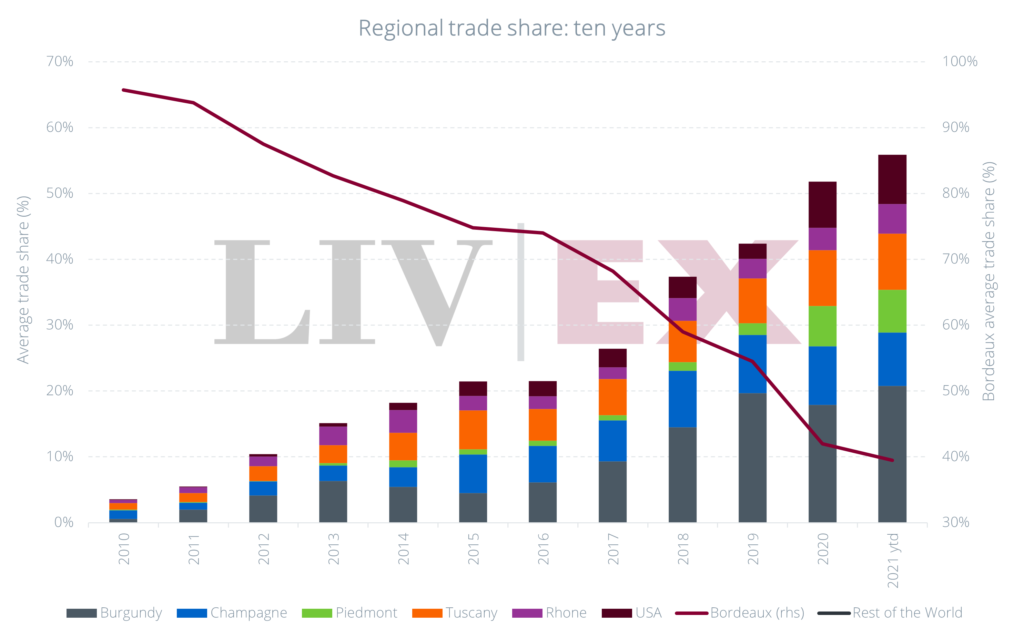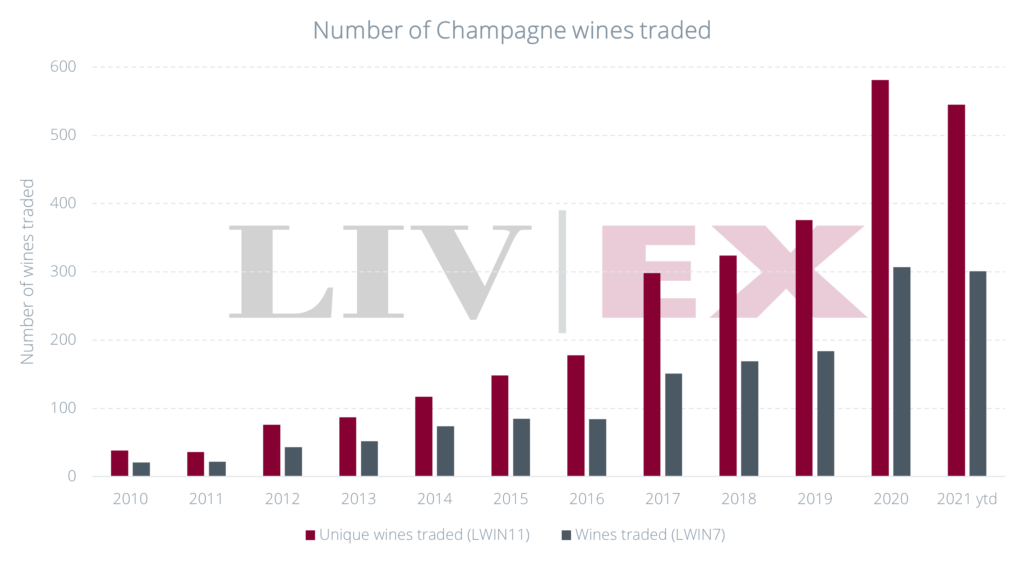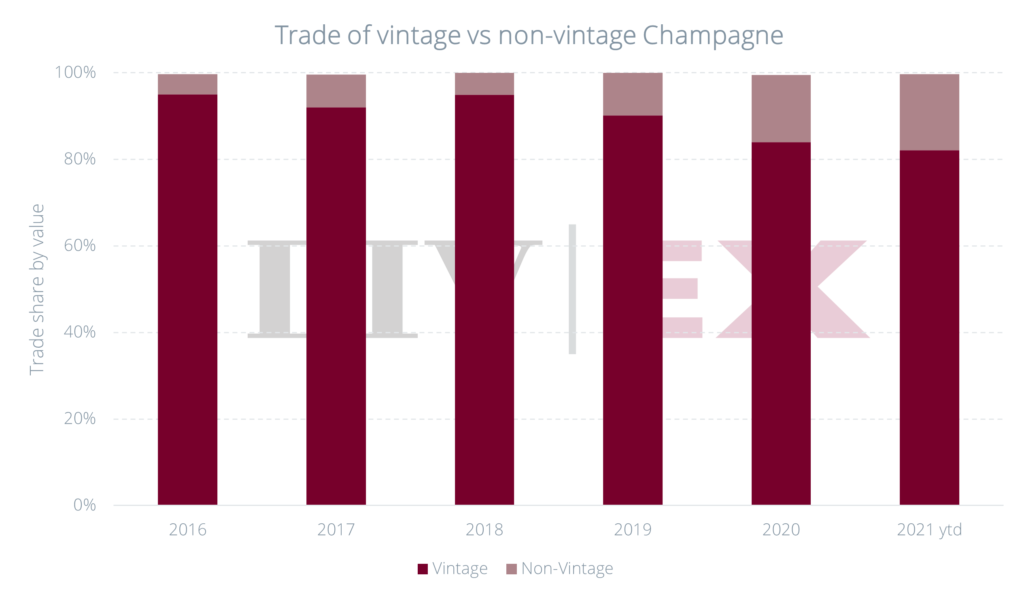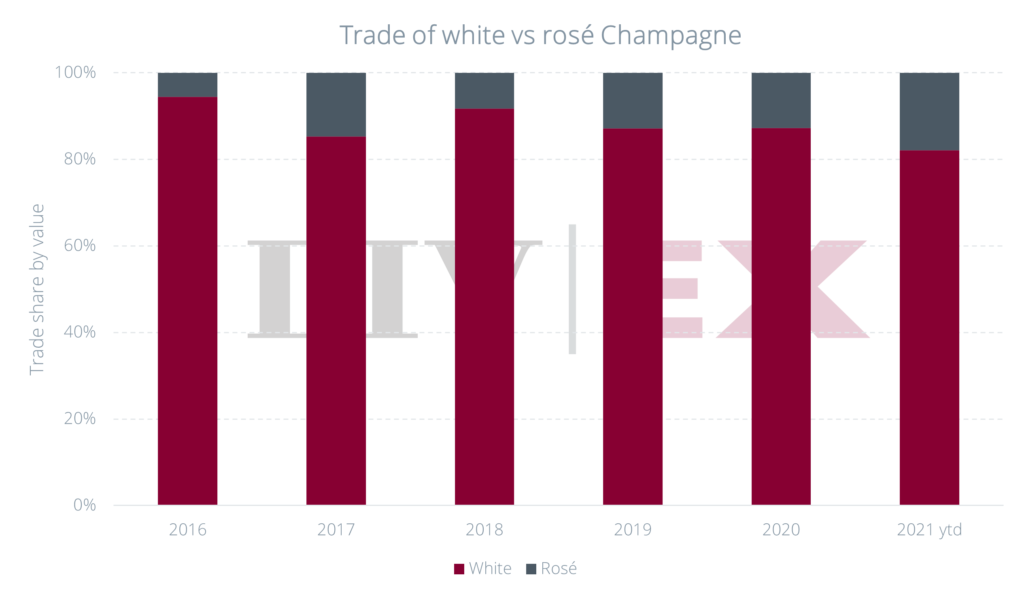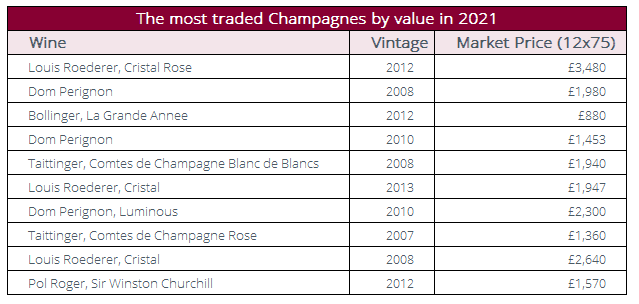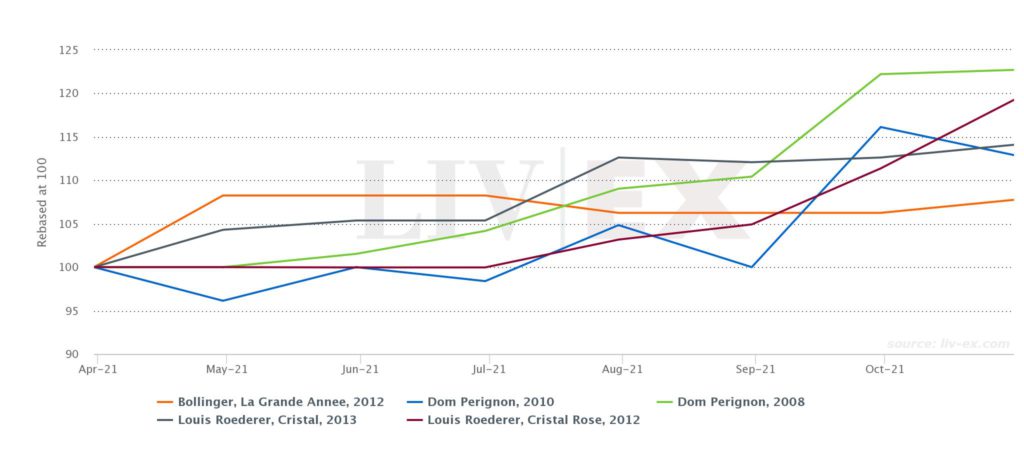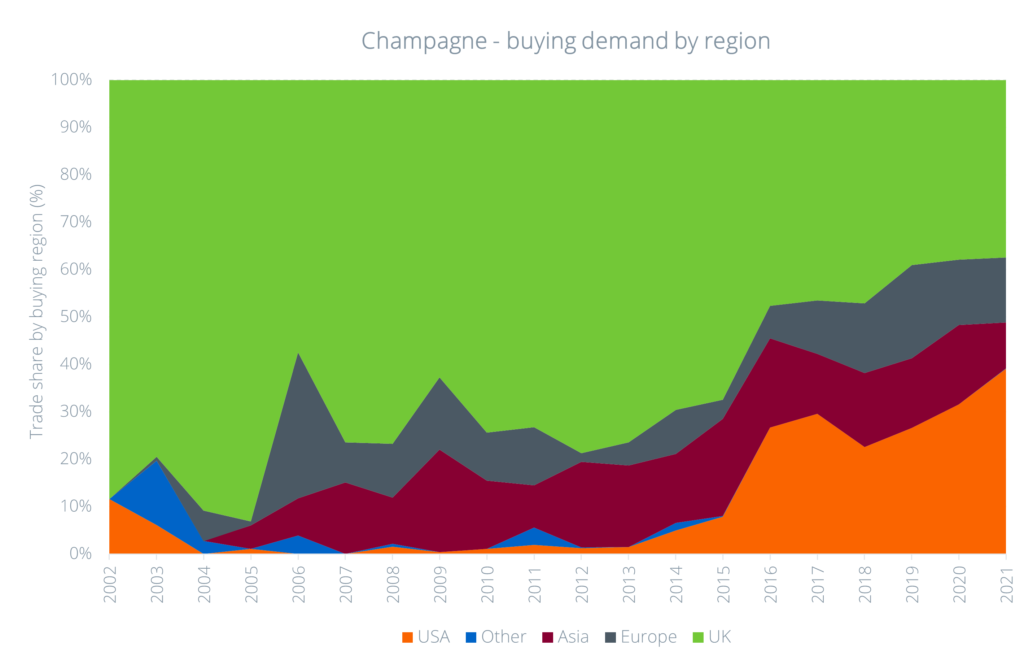- Champagne prices have risen 30% in the last year, more than any other region.
- Champagne has taken 8.1% of the market year-to-date, driven by US buying appetite.
- Trade of non-vintage Champagne has reached new heights.
- Louis Roederer Cristal Rosé 2012 has been the most traded wine by value, as the market for pink Champagne expands.
This year has brought numerous challenges for Champagne growers, with extreme weather reportedly causing immense damage to the crop, but it has proved to be one of the most exciting years for the region on the secondary market, where it has been going from strength to strength.
Below we provide an overview of the direction of prices, trading activity and the most in-demand Champagnes in 2021.
Champagne outperforms all fine wine regions in 2021
The Champagne 50 index, which tracks the prices of the most recent vintages of 12 Champagnes, closed October at an all-time high of 525.4.
The index has outperformed all other regional indices so far in 2021 (+23.8%) and over one year (30.0%). It has outgained other sub-indices including the Burgundy 150, the Italy 100 and the Bordeaux 500 during the fine wine’s market most bullish period in history.
But what is behind Champagne’s impressive rise?
Faster consumption leads to price hikes
Many Champagne brands benefit from both higher production and a wider distribution network than most fine wines. It can be found in various diverse environments – from restaurants through to nightclubs, special events and private cellars – and its brands resonate even among those who would not consider themselves to be fine wine drinkers.
Moreover, Champagne has been a very low volatile investment, unaffected by events that have stirred global markets. Its stability bolsters its investment appeal.
As the chart below shows, the Champagne 50 index (425.4%) has fared better than both the industry benchmark, the Liv-ex 100 index (272.4%), and the broadest measure of the market, the Liv-ex 1000 (305.4%) since their inception. The Champagne 50 has risen steadily almost every year, with no sharp downward movements, while the other major fine wine indices have suffered much steeper highs and lows.
The fourth most-traded fine wine region
Champagne has cemented its place in the secondary market for fine wine. Year-to-date, the region has taken 8.1% of total trade by value, making it the fourth-most traded region, after Bordeaux (39.5%), Burgundy (20.8%) and Tuscany (8.5%). Its trade share has grown substantially since 2010 when represented just 1.3% of the market.
Greater variety of Champagnes trading
The number of wines that have traded on the secondary market has also grown. So far in 2021, 545 different wines (measured as LWIN11s) have traded, up 1,334.2% since 2010.
The number of wine producers (measured as LWIN7s) that have found the bid has risen by a similar amount, and now stands at 301. The higher number of brands trading also points to the increased diversity of producers entering the secondary market at all levels – including non-vintage Champagne.
*LWINs are unique seven, 11, 16 or 18-digit codes. The seven-digit code – LWIN7 – refers to the wine itself i.e. Dom Pérignon. The longer codes include information about the vintage, bottle and pack size i.e. LWIN11 – Dom Pérignon 2010.
Non-vintage Champagne gains market share by value
The most-traded Champagnes by value this year have been non-vintage (NV), followed by the vintages 2012, 2008, 2007, 2010 and 2006.
With the increased broadening of the market, the trade share of NV Champagne versus vintage Champagne has also risen. Non-vintage has taken 17.6% of the Champagne market year-to-date, up from 15.5% in 2020, 9.8% in 2019 and 5.1% in 2018.
A growing market for pink bubbles
Blanc de blancs Champagnes continue to lead in terms of trade share but rosé Champagne has been an expanding category and has enjoyed the biggest price rises this year. Rosé is typically produced in smaller quantities and thus has lower liquidity than white Champagne, which has led to lower levels of trade.
However, pink bubbles have taken a record 18% of the Champagne market by value so far in 2021. And a new high of 89 rosé Champagnes have traded on Liv-ex so far this year.
A rosé Champagne tops the region’s most traded wines in 2021
A rosé has been the most traded Champagne in 2021 – Louis Roederer Cristal Rosé 2012 which boasts 99-points from Jeb Dunnuck and James Suckling. Cristal 2013 and 2008 have also been met with strong demand.
Dom Pérignon, which has been the most traded Champagne brand in 2021, has led with its 2008 and 2010 vintages.
The recent price performance of the five most active wines can be seen in the chart below. Dom Pérignon 2008 has risen the most; up 52.5% since the start of the year. Its 2010 vintage is up 17.2%.
*made with the Liv-ex Charting tool.
US has been the biggest buyer in 2021
The US has emerged as the biggest market for Champagne for the first time this year. It has taken a record 39.1% of trade by value, overriding the UK (37.4%) which has traditionally dominated buying.
Europe, particularly Belgium, Germany, Austria, Switzerland, the Nordics and France itself, has been the third biggest buyer at 13.7%; Asia has accounted for 9.7%.
Buyers worldwide can now take advantage of over 900 LIVE Champagne opportunities on the Exchange, starting from £16 to £6,000 per 1×75.
Liv-ex analysis is drawn from the world’s most comprehensive database of fine wine prices. The data reflects the real time activity of Liv-ex’s 530+ merchant members from across the globe. Together they represent the largest pool of liquidity in the world – currently £80m of bids and offers across 16,000 wines. Independent data, direct from the market.


